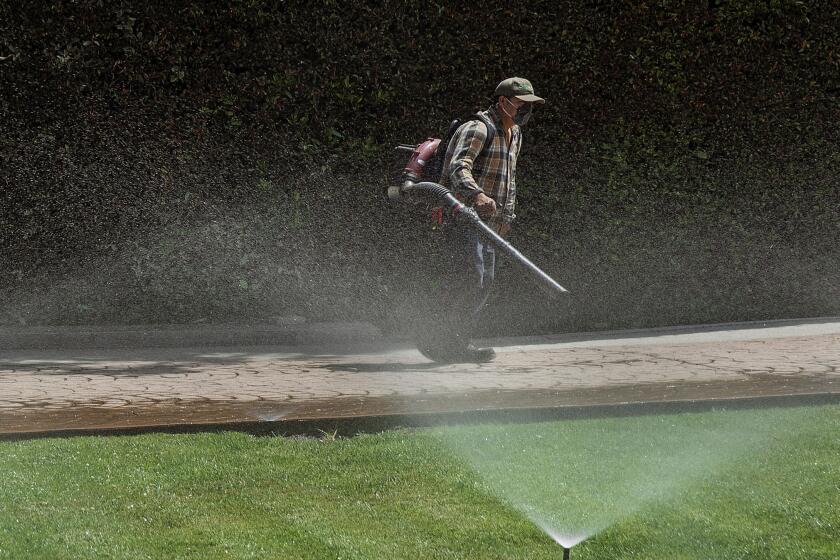Gardening : Keys to Planting Successful Azaleas : Flowers: Depending on varieties planted and location, they can produce brilliant blooms from October through June.
- Share via
Right now is peak azalea season, when nurseries offer the best selection of plants, bursting with brilliant bouquets of colorful blooms.
Azaleas are one of the few plants that provide showy color all winter long, can be grown in sun or shade, and never need replacing--at least they shouldn’t.
For many people, however, azaleas seem difficult to grow and easy to kill. Most often, the problem is associated with over-watering and poorly drained soil. The key to growing beautiful azaleas is proper planting and watering.
It is also important to choose the appropriate variety for each particular location with regard to sun exposure and climate. With careful selection of early-, mid- and late-blooming varieties you can have azaleas blooming in your yard nine months out of the year, October through June.
Azaleas like to be kept moist, but not soggy. Always water deeply when you do water. This will help prevent brown leaf tips caused by salts in the water. Water only when the top of the soil begins to dry out.
In cool, shady locations this may be only two or three times a month, depending on the weather. During the summer, in hot, sunny areas, you may need to water every three or four days. When in doubt, don’t water--azaleas can tolerate dry soil much better than soggy soil.
Azaleas must be planted in well-drained soil. If your azalea looks like someone took a blow torch to it, most likely it is planted in heavy, hard or clay soil, which drains slowly.
The appearance of an over-watered azalea is often deceiving because the plant often appears drier than normal and the leaves may turn brown. You naturally assume the poor thing needs more water, and you water it even more.
The fungus Phytophthora occurs in soggy soils and is responsible for a significant percentage of azalea casualties. The plant first exhibits poor vigor, then begins to look dry, leaves turn brownish-green and there is no new growth.
Other soil inhabiting fungi, commonly associated with poorly drained soils, cause root rot and affect the plant by causing young leaves to yellow and wilt. Small leaves and reduced vigor also occur from root rot.
To prevent fungus diseases and problems associated with over-watering, proper planting is essential. Here’s how to plant:
Dig a hole at least twice as wide and one foot deeper than the container the plant comes in. Mix plenty of peat moss with some of the soil from the hole. Milfeld’s wholesale azalea nursery in Riverside, known for its beautiful, top-quality azaleas, recommends planting in 80% coarse peat moss and 20% good, light soil.
The peat moss helps provide an acidic soil environment that azaleas love. If your soil is clay or hard you will be planting in almost straight peat moss, using only about 10% of the soil from the hole, mixed together with the peat moss.
Place the plant so that it is 1 to 1 1/2 inches above ground level. Fill in with the peat and soil mixture and water thoroughly. Avoid stepping on the soil to tamp it down. This causes compaction and reduces the great drainage and aeration you just worked so hard to create.
Many azaleas can be grown in full sun. Milfeld’s nursery recommends Southern Indica varieties for full sun, and Belgian Indica, Kurume and Rutherfordiana varieties for shade. Make sure you get the right plant for the right location.
All azaleas are classified as early-, mid- or late-blooming varieties. According to Milfeld, early season sun-types bloom January-March, early season shade-types bloom October-February, mid-season sun-types bloom March-April, mid-season shade-types bloom February-April and late season sun and shade-types bloom April-May.
Satsuki varieties bloom May-June. Two spectacular red sun azaleas, classified as early to late bloomers, are ‘Red Wing’ and ‘Red Bird.’ They bloom seven to eight months of the year, prolifically at times, and at least spot blooms the rest of the time.
‘Alaska’ is another exceptional variety, a long-blooming, white, early- to mid-season shade azalea. ‘Fielders White,’ a mid-season sun azalea, is another outstanding white.
Azaleas are slow growers and light feeders. Fertilize three or four times a year during the spring and summer months, using Miracid or any good azalea acid fertilizer. Leaves that turn yellow with the veins remaining green indicate an iron deficiency (iron chlorosis)--treat with iron chelate.
Azaleas are relatively pest-free, but occasionally fall prey to spider mites. Silvery leaves, with webbing beginning on the undersides of the leaves and later covering the entire leaf, indicate their presence.
Bud mites are another type of mite that sometimes attacks azaleas, causing curled and distorted new foliage. For both types of mites spray with Cygon, Diazinon or Mavrik, according to label directions.





